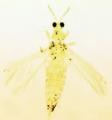Scirtothrips ewarti
Recognition data
Distinguishing features
Both sexes fully winged. Body yellow, abdominal tergites with antecostal ridge grey; antennal segment I pale, II–VIII grey; major setae brown; fore wings pale. Head wider than long, cheeks constricted to base, mouth cone extending between fore coxae; ocellar region apparently without sculpture, postocular region transversely striate; 3 pairs of ocellar setae present, pair III close together between anterior margins of hind ocelli. Antennae 8-segmented; III–IV with forked sensorium. Pronotum with closely spaced sculpture lines; posterior margin with four pairs of setae, S2 prominent and about 45 microns long. Metanotum apparently weakly reticulate medially; median setae wide apart and far back from anterior margin; no campaniform sensilla. Fore wing first vein with 3 setae on distal half, second vein with 4 widely spaced setae; posteromarginal cilia wavy. Abdominal tergites III–VI median setae small, not close together; II–VIII with lateral thirds covered in closely spaced rows of fine microtrichia, these microtrichial fields with 4 discal setae, posterior margin with fine comb; tergite VIII comb complete, lateral discal microtrichia extend medially across anterior half; tergite IX with several rows of discal microtrichia. Sternites without discal setae; no microtrichia across the median area; posterior margins without microtrichia.
Male smaller than female; tergite IX without paired drepanae; hind femora without comb-like row of stout setae; sternites without pore plates.
Variation
The major character state on which this species is distinguished, the length of the mouth cone, is particularly difficult to evaluate because it is so dependent on the degree of compression of a slide mounted specimen forcing the mouth cone into a posterior position. None of the available slide-mounted paratype specimens are sufficiently well-prepared for satisfactory photomicrography.
Related and similar species
S. ewarti is apparently similar to the little known Californian species, S. albus Jones, in having an unusually long mouth cone. It differs from the common yellow species in California, S. citri, in having the pronotal posteroangular setae considerably longer. The genus Scirtothrips currently includes 100 listed species from various parts of the world. Bailey (1964) provided keys to 13 from North America, but that work was based on specimens that were not fully cleared, and thus few structural details were available concerning differences between species. Similarly, Johansen & Mojica-Guzman (1999) provided keys to 33 species from Mexico, but doubts have been expressed concerning the biological reality of many of these (Mound & zur Strassen, 2001). Hoddle & Mound (2003) provided information on 21 Scirtothrips species from Australia, and Rugman-Jones et al. (2006) produced a molecular key to several pest species in this genus.
Taxonomic data
Current valid name
Scirtothrips ewarti Bailey
Original name and synonyms
- Scirtothrips ewarti Bailey, 1964: 341
Family placement
Thripidae, Thripinae
Biological data
Life history
Presumably breeding on leaves.
Host plants
Adults have been collected from three desert-living, native plant species in three different families, Tetracoccus (Euphorbiaceae), Larrea (Zygophyllaceae) and Simmondsia (Simmondsiaceae).
Tospoviruses vectored
None
Crop damage
None
Distribution data
Area of origin
Western USA
Distribution
California





